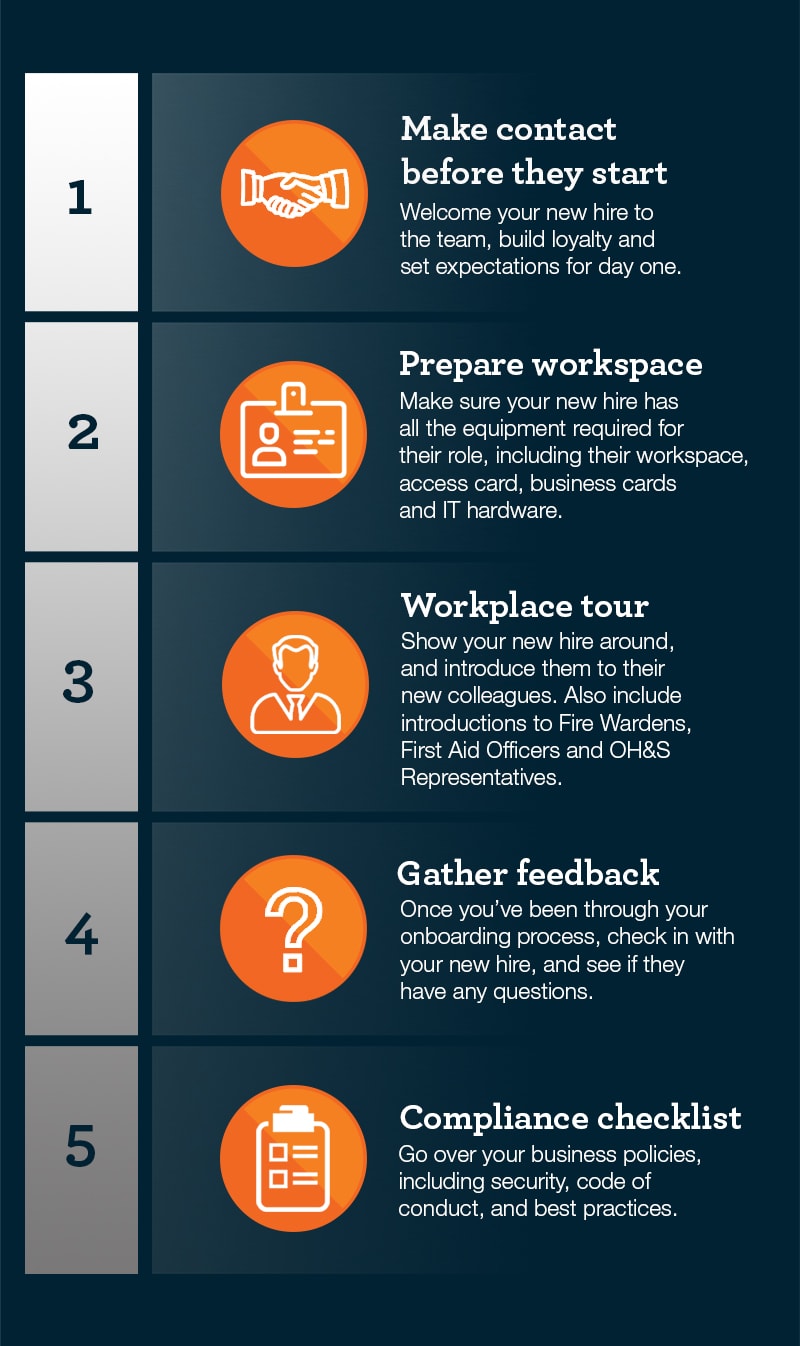
So, you’ve hired a new employee and don’t know where to start. Not to worry! This 19-step onboarding and induction process ensures new hires (and current team members) are ready to hit the ground running on their first day.
What’s the difference between onboarding and induction?
There can be confusion about the difference between onboarding and induction, which is made worse by some professionals using these terms interchangeably. However, there is a key difference:
- Onboarding happens after a new hire has signed their employment offer but before their first day. It may include sending welcome packs, employee forms, an introduction from a direct line manager, or information about how they can get to the office and what to expect on their first day.
- Induction happens from a new hire’s first day onwards. It may include induction training, organisational introductions, office orientation, or connecting them with a mentor.
Why is employee induction important?
To maximise productivity and get the best out of your new employees, you have to take steps to ensure that they:
- Feel welcome and respected in the workplace
- Understand your business and their role within it
- Have access to everything they need to perform their job well
- Begin building great relationships within the team
- Perform at their best
This requires forward planning, which is where an onboarding and induction process comes in.
Your Career in Human Resources
Do you want to learn more about HR skills employers demand, emerging job roles and salaries, and recent industry insights?
Discover your career in human resources.
HUMAN RESOURCES CAREER PAGE
Employee onboarding process
The onboarding process begins upon a new hire’s acceptance of their employment offer. Ideally, this is at least 10 days before their first day.
1. Forward all necessary paperwork. This includes a signed contract and offer letter, an employee details form, and a signed tax declaration form. You may have an HR system such as Employment Hero that automates some of this for you.
2. Organise access cards. If employees require office access cards or cards for the printer or other office equipment, set this up and leave it on their desk ahead of their first day.
3. Arrange business cards. If the new hire requires a business card, whether physical or virtual, organise the printing or set-up of these cards and leave these on their desk or give them access.
4. Organise corporate charge card. If the new employee is required to travel for business or needs access to a company credit card, set this up so it’s ready for their first week.
5. Phone set-up. This may include providing a desk phone or mobile phone, updating the phone directory on the company intranet and ensuring that voicemail facilities and instructions are available.
6. Laptop and IT applications. You’ll need to advise IT of the new employee’s start date so that they can set up an email account and arrange internet access. IT should also ensure the new hire’s laptop is allocated and set up with the required software and applications pre-installed.
7. Assign and clear their workspace. This is a wonderful opportunity to go the extra mile to make them feel welcome. Provide a notebook, pen and a highlighter, or set up a welcome sign or first-day goodie bag. Add any other resources they’ll require like their laptop, phone, business cards, access cards, etc. If the new starter will have an allocated desk, ensure their ergonomic equipment, additional screens, keyboard, mouse, etc. is set up for them. If your company uses a hotdesking model, you can place everything in a basket and provide this to them on their first day.
Copy the following embed code to share on your website:
Click on the text to copy the embed code.
8. Prepare the new starter’s manager. Ensure the manager of the incoming staff member:
- Has been briefed and is adequately prepared for the arrival
- Fully understands the position description
- Can communicate the position’s SMARTA objectives, KRAs and KPIs
- Has a free time slot in their calendar for a meet and greet
9. Communication with current staff members. Advise current staff and key contacts of the new employee’s start date. You may wish to allocate a ‘buddy’ for the new starter and brief them of their responsibilities.
10. Arrange meeting times with key stakeholders. These meetings can be spread over the first week rather than the first day. Just make sure that you book meet and greets individually or as a team with anyone the new starter needs to form closer relationships with.
11. Create a first-day or week package. This consists of materials and training the new starter will need for their first day or week. It should align with the specific role of the incoming employee and include a list of key contact information, training sessions that must be completed, policies to read and acknowledge, accounts to set up, access permissions to check, specific induction training (e.g. IT, intranet, software, processes or team-specific induction), and so on. A first week calendar can be helpful with meetings blocked in and time allocated for various induction activities.
12. Contact the new starter. Send a pre-welcome email that runs through details for location and start-time on their first day, who to ask for when they arrive, and what to expect on the day. This is also the opportunity to answer any questions they may have. Ideally, you should send the email a week before their start date. It should be sent from their direct line manager or the HR manager with the direct line manager cc’d in.

Employee induction process
Induction begins on the new starter’s first day and typically ends after the six-month probation period.
13. Welcome and introduce them to the team (and their ‘buddy’).
14. Workplace tour. Ensure that you include first aid information, toilets, stationery cupboards, kitchen facilities, meeting rooms, fire fighting equipment, security controls and procedures, building access cards, and their desk. Your tour should also include an explanation of evacuation procedures and assembly areas and an introduction to wardens, first aid officers and WHS committee representatives.
15. Explain HR procedures. Ensure all required paperwork is completed and returned to HR and explain procedures including pay cycles, leave, access to benefits, the code of conduct, applicable policies and their position description.
16. Compliance checklist. Create a comprehensive checklist for new employees to complete and sign, stating that:
- The company has made every reasonable effort to help them understand their rights and obligations under the law and your policies
- They understand their rights and obligations
- They understand and agree to your business policies
- They understand their role, responsibilities, KPIs and performance framework
17. Ensure everything is working for your new employee. Check that all required software, intranet, databases and emails can be accessed, that phones are properly set up and that everything is in place.
18. Book milestone check-ins. Book regular check-ins with your new starter throughout their first six months or until their probationary period ends. These check-ins should provide opportunities for Q&A, issue resolution and are a great source of feedback for the HR team. Ideally, this will include check-ins at one week, two weeks, the end of the first month, and then monthly until their probation period has finished. After this, your standard annual, six-monthly or quarterly performance strategy check-ins should be sufficient.
19. Probationary meeting. This is typically at the six-month mark and confirms whether an employee has successfully passed their probation period or whether their role is coming to a close. As you’ve been checking in regularly, providing feedback and answering questions, the outcome of this meeting should not be a surprise to either party. It’s also best practice to send an email confirming their probation outcome and any additional information they need to know.
Create your own onboarding and induction process
You will need to tailor this 19-step employee onboarding and induction guide to your own business, but this will provide you with a great framework to do so.
Download our FREE HR Career, Salary & Course Guide!
Find valuable information on why you should become a HR manager, which HR department suits you, a detailed salary guide, course breakdown and more!








Comments are closed.